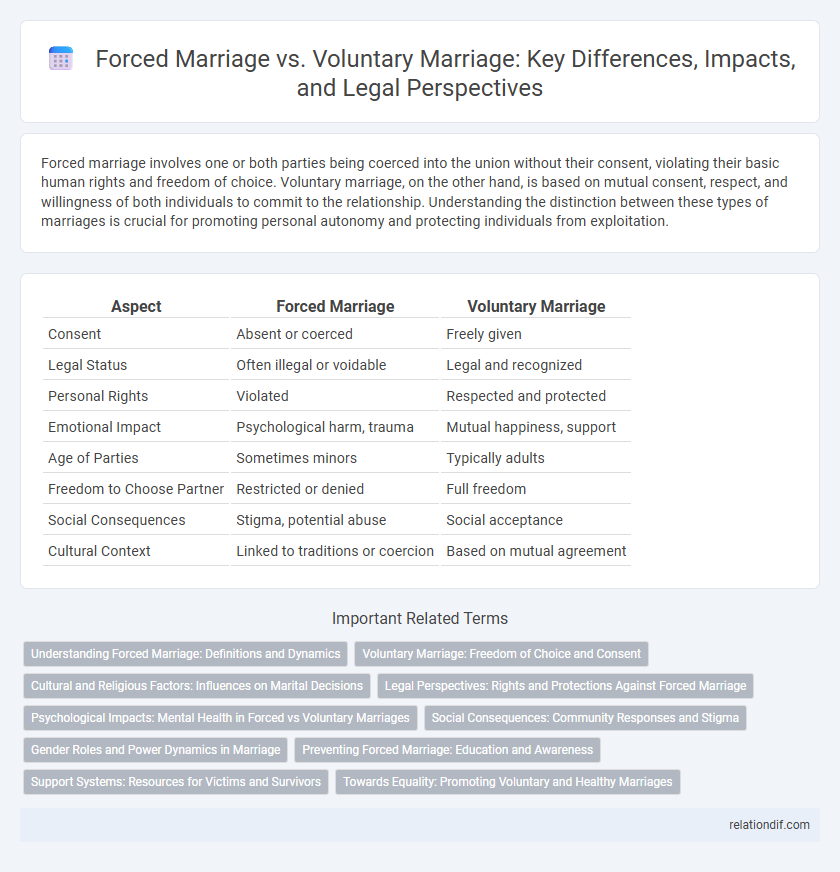Forced marriage involves one or both parties being coerced into the union without their consent, violating their basic human rights and freedom of choice. Voluntary marriage, on the other hand, is based on mutual consent, respect, and willingness of both individuals to commit to the relationship. Understanding the distinction between these types of marriages is crucial for promoting personal autonomy and protecting individuals from exploitation.
Table of Comparison
| Aspect | Forced Marriage | Voluntary Marriage |
|---|---|---|
| Consent | Absent or coerced | Freely given |
| Legal Status | Often illegal or voidable | Legal and recognized |
| Personal Rights | Violated | Respected and protected |
| Emotional Impact | Psychological harm, trauma | Mutual happiness, support |
| Age of Parties | Sometimes minors | Typically adults |
| Freedom to Choose Partner | Restricted or denied | Full freedom |
| Social Consequences | Stigma, potential abuse | Social acceptance |
| Cultural Context | Linked to traditions or coercion | Based on mutual agreement |
Understanding Forced Marriage: Definitions and Dynamics
Forced marriage is a union where one or both individuals are married without their free and full consent, often resulting from coercion, threats, or manipulation. This practice violates human rights and disregards individual autonomy, distinguishing it sharply from voluntary marriage based on mutual agreement. Understanding the social, cultural, and legal dynamics behind forced marriage is crucial for effective intervention and support.
Voluntary Marriage: Freedom of Choice and Consent
Voluntary marriage is based on the freedom of choice and mutual consent of both individuals, ensuring that neither party is coerced or pressured into the union. This type of marriage upholds fundamental human rights and personal autonomy, allowing partners to enter the relationship willingly and with full awareness. Legal frameworks worldwide increasingly emphasize the importance of consent to protect individuals from forced marriage practices and promote healthy, equitable partnerships.
Cultural and Religious Factors: Influences on Marital Decisions
Cultural and religious factors profoundly shape marital decisions by dictating norms and expectations within communities, often distinguishing forced marriages from voluntary unions. In many societies, traditional beliefs and religious doctrines prioritize family honor, social cohesion, and adherence to prescribed roles, which can lead to coercion or lack of consent in marriage arrangements. Conversely, voluntary marriages are typically characterized by mutual agreement and personal choice, reflecting evolving interpretations of cultural and religious values that emphasize individual autonomy and compatibility.
Legal Perspectives: Rights and Protections Against Forced Marriage
Legal frameworks universally recognize voluntary marriage as a fundamental human right rooted in free and informed consent, whereas forced marriage contravenes these principles, violating individual autonomy and freedom. Laws against forced marriage provide protections including annulment, criminal penalties for coercers, and support services for victims, reinforcing the importance of consent in marital unions. International conventions, such as the Universal Declaration of Human Rights and CEDAW, underscore states' obligations to prevent forced marriages and safeguard individuals' rights to enter marriage freely.
Psychological Impacts: Mental Health in Forced vs Voluntary Marriages
Forced marriages often result in severe psychological distress, including anxiety, depression, and post-traumatic stress disorder, due to the absence of consent and autonomy. In contrast, voluntary marriages are typically associated with better mental health outcomes, as mutual consent fosters emotional security and personal well-being. Research indicates that individuals in forced marriages experience higher rates of psychological trauma and diminished self-esteem compared to those in voluntary unions.
Social Consequences: Community Responses and Stigma
Forced marriage often results in severe social consequences, including ostracism and stigmatization within the community, as victims are viewed through lenses of victimhood and dishonor. In contrast, voluntary marriage tends to be embraced by social networks, fostering acceptance and support that strengthen communal bonds. Communities with prevalent forced marriage may experience heightened social tensions and decreased trust, undermining overall social cohesion.
Gender Roles and Power Dynamics in Marriage
Forced marriages often reflect entrenched gender roles and imbalanced power dynamics, where one party--typically women--has limited autonomy and is subjected to coercion or control. Voluntary marriages tend to exhibit more equitable power distribution, allowing both partners to negotiate roles based on mutual consent rather than societal or familial impositions. These contrasting dynamics highlight the critical impact of agency and gender equality on marital stability and individual well-being.
Preventing Forced Marriage: Education and Awareness
Education and awareness programs play a crucial role in preventing forced marriages by empowering individuals with knowledge about their rights and the legal consequences of coercion. Community engagement initiatives promote discussions on consent, gender equality, and personal autonomy, helping to dismantle cultural norms that perpetuate forced marriage. Comprehensive sex education and targeted campaigns in schools and rural areas significantly reduce the prevalence of forced marriages by encouraging voluntary, informed decisions.
Support Systems: Resources for Victims and Survivors
Support systems for victims of forced marriage include specialized helplines, legal aid services, and counseling centers that provide confidential assistance and safety planning. Voluntary marriage support resources often focus on premarital counseling, relationship education, and conflict resolution to foster healthy partnerships. Community organizations and government agencies play a critical role in offering protection, advocacy, and reintegration programs tailored to survivors' needs.
Towards Equality: Promoting Voluntary and Healthy Marriages
Promoting voluntary and healthy marriages is essential for advancing gender equality and individual autonomy. Forced marriages violate human rights and often lead to psychological trauma, social isolation, and limited opportunities for victims, predominantly affecting women and girls. Empowering communities with education, legal protections, and support systems fosters informed consent and equal partnerships, ensuring marriages are based on mutual respect and free will.
Forced Marriage vs Voluntary Marriage Infographic

 relationdif.com
relationdif.com